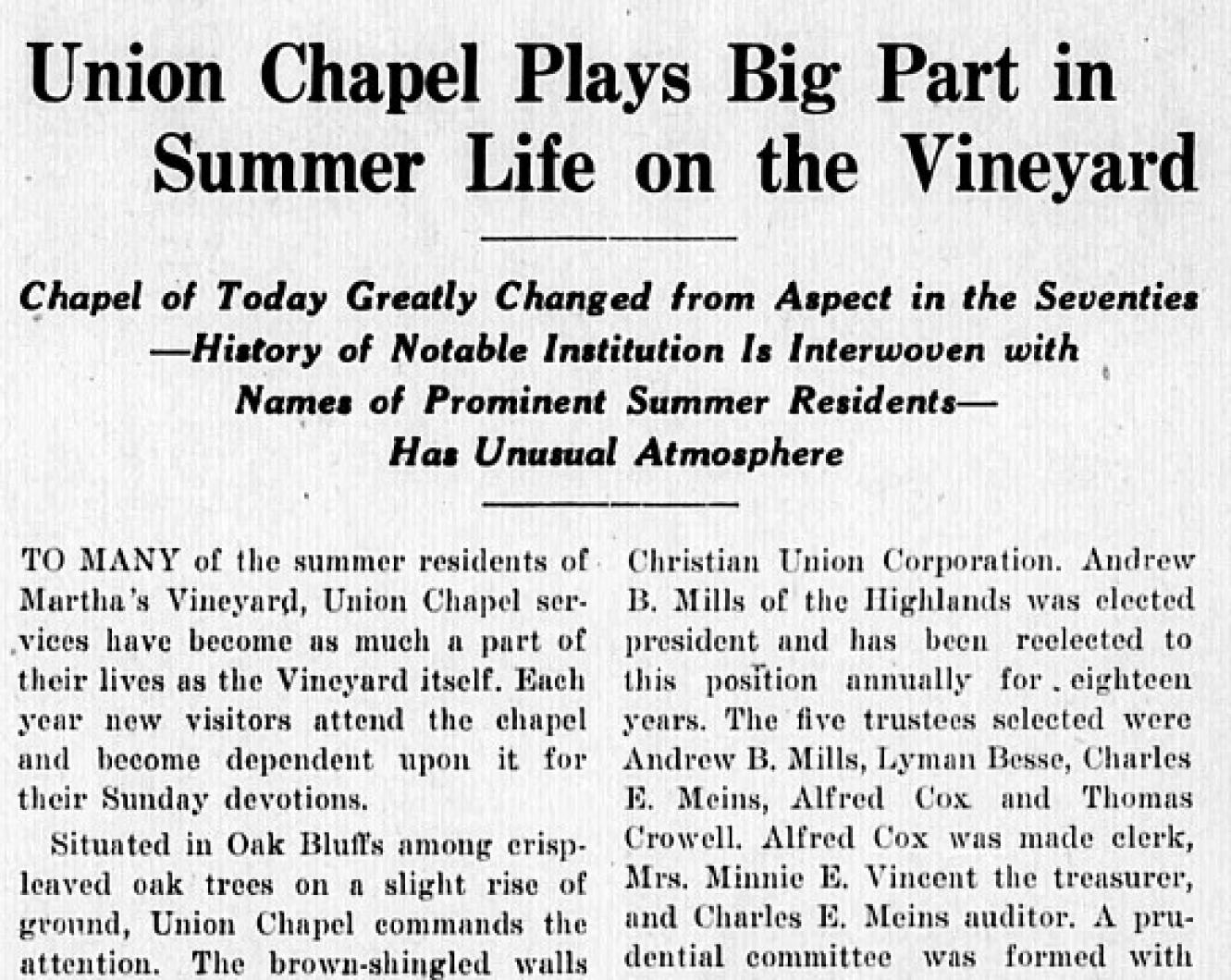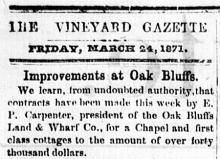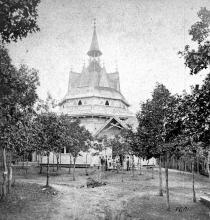To many of the summer residents of Martha’s Vineyard, Union Chapel services have become as much a part of their lives as the Vineyard itself. Each year new visitors attend the chapel and become dependent upon it for their Sunday devotions.
Situated in Oak Bluffs among crisp-leaved oak trees on a slight rise of ground, Union Chapel commands the attention. The brown-shingled walls form an octagon shape and on every side of the building’s four entrances green lawns slope down to the adjacent avenues. The somewhat unusual architecture is well adapted for services as the high ceiling and wide doorways allow light and fresh breezes to keep the chapel cook and pleasant. Through the open entrances birds occasionally fly in, perch on a high beam, and blend their voices with those of the quartet. The trim apple green and white interior makes ever shaft of sunlight seem brighter and gives an effect of quiet woodland worship.
The chapel did not always present such an attractive appearance to its congregation. Many can remember bizarre yellow and crimson scrollwork, enlivening balcony and outside trim. Two spires rose in pinnacled glory and fantastic roccoco ornaments made the building an outstanding example of the “gingerbread” age.
To the eyes of the ‘70s, however, this medley of many ages of architecture, plus the efforts of the fertile imaginations of the period, was a stroke of consummate genius. On the triangle of land staked out in 1869 the building was erected and by 1872 services were being held. Although little can be ascertained concerning its founding and first days, the Gazette files of August 30, 1872, reveal that “A large company assembled at Union Chapel for morning and afternoon services. Rev. Dr. Sheldon of Troy, N.Y., preached a stirring morning sermon, and Dr. Upham of New Bedford officiated in the afternoon.”
In 1880 the Oak Bluffs Christian Union Association was organized and it became the custom for the Rev. S. F. Upham to preach the first sermon each year. Already the chapel was well known for its splendid singers, and ministers from all over the country were obtained to preach. The Oak Bluffs Christian Union Association was organized for the purpose of conducting religious services undenominational in character, and this policy has been adhered to throughout the history of the chapel.
Before the reorganization in 1913 Ezra B. Tuttle of Brooklyn, N. Y. and Oak Bluffs was prominent for his services. It was his pleasure to engage the finest musicians and preachers for the chapel and to personally extend the kindest of hospitality to them. B. F. Corbin, father of Charles F. Corbin, an annual summer resident of Oak Bluffs, was well-known for his devotion to the work of the church. Until 1921 Dr. Francis B. Upham, son of Dr. S. T. Upham, succeeded his father in opening the services each summer.
By 1913 the leading men of the chapel felt that a more efficient organization was necessary and on July 11, 1913 the commonwealth of Massachusetts gave a grant to the Oak Bluffs Christian Union Corporation. Andrew B. Mills of the Highlands was elected president and has been reelected to this position annually for eighteen years. The five trustees selected were Andrew B. Mills, Lyman Besse, Charles E. Meins, Alfred Cox and Thomas Crowell. Alfred Cox was made clerk, Mrs. Minnie E. Vincent the treasurer, and Charles E. Meins auditor. A prudential committee was formed with Ezra B. White, Walter Ferris and Henry S. Hand as members. The care of the chapel and grounds was given to Mr. Meins and it has been his task to make the chapel the pleasant place it is today. The year after the death of his father, Winthrop B. Tuttle of Brooklyn and Edgartown became a member of the prudential committee, and at the same time Mr. Meins was appointed treasurer.
In the succeeding years the unfortunate deaths of many of the officers brought new names into prominence.
In 1915 Henry Hand was made auditor and Melville B. Fuller a trustee. Two years following, Levi B. Dowley became auditor and Henry Hand treasurer. William J. Mills and Wilhelmus B. Bryan were elected trustees. In 1921 Mr. Fuller was made auditor, Mr. Bryan treasurer and William D. Faris trustee. The number of trustees was increased in 1924 to seven and Frederick A. Myers and Albert L. Scott were added to the list. At the same time George Knight became a member of the prudential committee and Winthrop Tuttle was made auditor. The next year Mr. Myers was elected clerk and Lyman Besse a member of the prudential committee. In 1927 Walter M. Bennet became a trustee and clerk to the corporation. Last year Chesterton Knight was chosen to fill the position of auditor of the prudential committee and a trustee.
Mr. Mills and Mr. Meins, the only officers of the reorganization alive today, look back with sadness on the passing of so many of their friends and compatriots. They will always be remembered, however, for their untiring efforts in establishing so helpful an organization as is Union Chapel.
In gaining funds for the new organ and conducting the business entailed in having it placed in the chapel in 1924, Wilhelmus Bryan and Mr. Meins were singularly able and indispensable. Again in 1928 theme men beautified the chapel by having the bell and tower removed and by building an addition to the south entrance for minister’s and choir’s rooms.
Today when the popularity of Union Chapel is such that people stand to hear the services when all seats are taken, little though is given to the past history of the organization. Such unswerving loyalty, such hard toil as has been given by its members are the things of which the success of the institution has been made. In the congregation’s enjoyment of the celebrated singing and excellent preaching perhaps these pioneers have found sufficient reward.










Comments